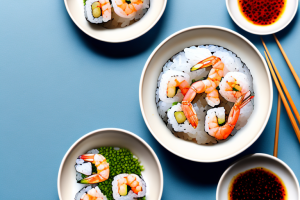How to prepare sushi rice with salmon
8 min read
A bowl of sushi rice topped with salmon
If you’re a fan of sushi, you may have already tried making some at home. However, mastering the art of making sushi can be quite challenging, especially if you want to prepare it with raw salmon. In this article, we will provide you with step-by-step instructions on how to prepare sushi rice with salmon that will leave you with restaurant-quality results.
What ingredients do you need to make sushi rice and salmon rolls?
Before you start preparing your sushi rice and salmon, it’s important to ensure that you have all the necessary ingredients. For the sushi rice, you’ll need short-grain rice, water, salt, sugar, and rice vinegar. For the salmon, you’ll need fresh, sushi-grade salmon, which you can find at any specialty fish market. Additionally, you’ll need nori sheets, wasabi paste, pickled ginger, and soy sauce.
It’s important to note that when selecting your salmon, you should choose a piece that is firm to the touch and has a bright, vibrant color. It’s also recommended to freeze the salmon for at least 24 hours before using it in your sushi rolls to ensure that any potential parasites are eliminated. Once you have all your ingredients, you can begin preparing your sushi rice by rinsing it thoroughly and cooking it according to the package instructions. Then, you can assemble your sushi rolls by placing a sheet of nori on a bamboo mat, spreading the rice evenly over the nori, adding slices of salmon, and rolling it tightly. Serve with wasabi, pickled ginger, and soy sauce for a delicious and authentic sushi experience.
Understanding the different types of sushi rice for preparing your meal
Sushi rice is a short-grain rice variety that is particularly sticky and sweet, allowing it to hold its shape when rolled. There are different types of sushi rice, varying in quality and price. Your best option is to choose a medium-quality sushi rice, which will give you good results without breaking the bank.
It is important to note that the preparation of sushi rice is just as important as the type of rice you choose. The rice needs to be washed thoroughly to remove excess starch and then cooked with the right amount of water and vinegar to achieve the perfect texture and flavor. It is also recommended to let the rice cool down to room temperature before using it for sushi rolls. With the right type of rice and proper preparation, you can create delicious and authentic sushi at home.
The right way to cook sushi rice for your salmon dish
The first step in preparing your sushi rice is to wash it in cold water until the water runs clear. Then, soak the rice in cold water for 20-30 minutes before cooking it. For every cup of rice, add one and a half cups of water to a pot and bring it to a boil. Reduce the heat, cover the pot, and simmer for 15-20 minutes until the water has been fully absorbed. Remove the pot from heat and let it sit covered for an additional 10 minutes before fluffing the rice with a fork.
It is important to note that the quality of the rice used in sushi can greatly affect the overall taste and texture of the dish. Look for short-grain rice that is specifically labeled as sushi rice for the best results. Additionally, some chefs recommend adding a small amount of rice vinegar and sugar to the cooked rice for added flavor and to help the rice stick together when forming sushi rolls.
When serving sushi rice with salmon, it is common to season the salmon with soy sauce and wasabi. However, for a unique twist, try topping the salmon with a mixture of diced avocado, cucumber, and sesame seeds for added texture and flavor. This will create a refreshing and delicious contrast to the warm, savory sushi rice.
How to select and prepare the salmon for your sushi rolls
When it comes to selecting the salmon for your sushi rolls, you should opt for sushi-grade salmon, which is fresh and safe to eat raw. Before using it, you’ll need to skin and debone the salmon fillet. To do so, hold the salmon with a pair of tweezers and use a sharp knife to cut the skin away. Then, remove the bones using a pair of pliers.
It’s important to note that not all salmon is suitable for sushi. Wild-caught salmon is generally preferred over farmed salmon, as it tends to have a better flavor and texture. Additionally, make sure to purchase your salmon from a reputable fishmonger who specializes in sushi-grade fish.
Once you’ve prepared your salmon, you can use it in a variety of sushi rolls. Some popular options include salmon nigiri, salmon avocado rolls, and spicy salmon rolls. Experiment with different combinations of ingredients to find your favorite sushi roll recipe!
Learn how to cut the salmon properly for your sushi rolls
When it comes to cutting the salmon for your sushi rolls, it’s important to keep the pieces uniform in size. To do so, start by cutting the salmon fillet in half lengthwise and then cutting each half into thin strips about ¼ inch wide.
It’s also important to use a sharp knife when cutting the salmon. A dull knife can crush the delicate flesh and ruin the texture of the fish. Additionally, make sure to remove any bones from the salmon before cutting it into strips. This will ensure that your sushi rolls are enjoyable to eat and free from any unwanted surprises.
Tips on rolling the perfect sushi with salmon and rice
Rolling sushi may seem intimidating at first, but with a little practice, it becomes second nature. Start by placing a piece of nori shiny side down on a sushi mat. Add a layer of prepared sushi rice to cover ¾ of the nori, leaving a small gap at the top. Add a small amount of wasabi paste in a line in the middle of the rice, then add a piece of salmon on top. Roll the sushi mat away from you, tucking in the ingredients as you go. Once you’ve rolled the entire nori sheet, use a sharp knife to slice the sushi roll into bite-sized pieces.
When it comes to rolling sushi, the quality of the ingredients is crucial. Make sure to use fresh salmon and high-quality sushi rice for the best results. It’s also important to use the right amount of rice and filling to ensure that the sushi roll holds together properly. Too much filling can cause the roll to burst, while too little can result in a loose and messy roll.
Another tip for rolling perfect sushi is to wet your hands with water before handling the rice. This will prevent the rice from sticking to your hands and make it easier to spread evenly on the nori sheet. Additionally, you can use a damp towel to clean your knife between cuts to ensure that each piece of sushi is clean and presentable.
The secret ingredient to making tasty and flavorful sushi rolls with salmon
If you’re looking to take your sushi rolls to the next level, you can add some flavorful toppings to them. Some popular options include avocado, cucumber, carrot, or cream cheese. Additionally, you can season the sushi rice with sesame seeds, chopped green onion, or soy sauce to add extra flavor.
Another way to enhance the flavor of your salmon sushi rolls is to use high-quality salmon. Look for sushi-grade salmon, which is specifically labeled for raw consumption. This type of salmon is typically fresher and has a better texture and taste than regular salmon. You can also try marinating the salmon in a mixture of soy sauce, mirin, and sake before using it in your sushi rolls.
Finally, the way you roll your sushi can also affect its flavor. Make sure to evenly distribute the ingredients throughout the roll and avoid overstuffing it. This will ensure that each bite has a balanced flavor and texture. You can also experiment with different rolling techniques, such as inside-out rolls or hand rolls, to create unique flavor combinations.
How to properly serve your homemade sushi rolls with salmon and rice
Serving sushi rolls with salmon and rice is an art in itself. To do so, arrange the sushi rolls on a plate with a small bowl of soy sauce and a small pile of pickled ginger. Don’t forget to add some wasabi to the soy sauce for some extra kick.
When serving sushi rolls with salmon and rice, it’s important to also consider the presentation. You can add some color and texture to the plate by including some thinly sliced cucumber or avocado. Additionally, you can sprinkle some sesame seeds or chopped scallions on top of the rolls for added flavor and visual appeal.
Another important aspect of serving sushi rolls is to ensure that they are at the right temperature. If the rolls have been refrigerated, allow them to sit at room temperature for a few minutes before serving. This will enhance the flavor and texture of the sushi rolls, making them more enjoyable for your guests.
Additional toppings and condiments to enhance the flavor of your sushi dish
If you’re looking to add some variety to your sushi rolls, there are many different toppings and condiments that you can experiment with. Some popular options include spicy mayo, eel sauce, sesame seeds, and tobiko, which is flying fish roe that adds a crunchy texture and salty flavor to your sushi rolls.
With these step-by-step instructions, you’ll be able to make delicious sushi rolls with salmon and rice that are sure to impress your friends and family. Remember to select fresh, high-quality ingredients and take your time when preparing and rolling the sushi. With a little patience and practice, you’ll soon be a sushi-making pro.
Another great topping to try is avocado, which adds a creamy texture and mild flavor to your sushi rolls. You can also experiment with different types of fish, such as tuna or yellowtail, to create unique flavor combinations. Additionally, adding a touch of wasabi or pickled ginger can provide a spicy or tangy kick to your sushi rolls.
When it comes to condiments, soy sauce is a classic choice for dipping your sushi rolls. However, you can also try ponzu sauce, which is a citrus-based sauce that adds a tangy and refreshing flavor to your sushi. Another option is teriyaki sauce, which provides a sweet and savory flavor that pairs well with sushi rolls containing cooked ingredients like shrimp or chicken.


